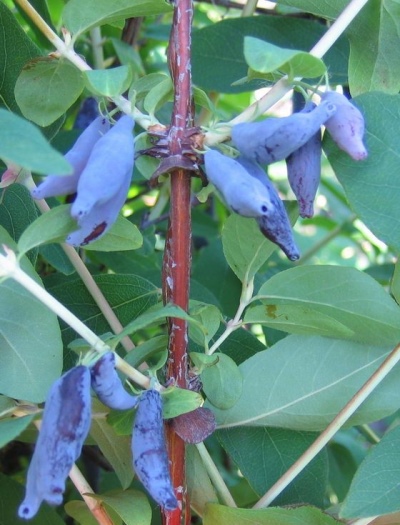
- Authors: L.P. Kuminov
- Year of approval: 1998
- Growth type: medium-sized
- Description of the bush: medium spreading
- Escapes: medium, straight, pink, hairless, matte
- Leaves: large, dark green, naked, matte, loose
- Flowers: large, yellow
- Fruit size: large
- Fruit weight, g: 1,1
- Fruit shape: elongated
The Gzhelka honeysuckle variety is considered to be universal: actively growing bushes not only bear fruit regularly, but also perform a decorative function, being used to form hedges. The plant is not whimsical and perfectly tolerates both low temperatures and unstable weather conditions.
Breeding history
The edible honeysuckle variety called Gzhelka was the result of the breeding activity of L.P. Kuminov. In 1998, the variety was recognized at the state level and included in the State Register. The berry cultivar was named after the Gzhelka River, located in the Moscow region.
Description of the variety
Honeysuckle Gzhelka grows as a bush of medium height and medium spreading. Its straight branches, the surface of which is devoid of a cannon, have a pink matte color. When growing Gzhelka in an open area, the shoots of the plant lengthen almost up to 2 meters. Instances developing in thickened conditions slow down in development and become stunted. The latter, however, does not in the least affect the crop yield. Thin shoots of the plant are covered with rather large dark green leaf blades. Flowering is accompanied by the appearance of large yellow buds.
Fruit characteristics
The honeysuckle variety Gzhelka produces large, elongated berries, painted in a dark blue color. Their length can be about 2.5 centimeters, and the shape is a bit like a curved pod. A bluish bloom is often visible on the thin, slightly pubescent skin. The weight of one fruit, sitting on a medium-sized green stalk, can reach 1.1 grams. The aroma of the berries is subtle and unobtrusive.
Taste qualities
The juicy pulp of honeysuckle has a sweet taste, devoid of bitterness. However, early and late harvests may have a slight sourness. Strong berries are used fresh, or they are used to make jams, jams, compotes, a variety of drinks and preparations. If the ripening of honeysuckle occurs in warm weather, then the fruits accumulate a large amount of sugar. Berries, the development of which took place in the rain and coolness, turn out to be more acidic.
Ripening and fruiting
Despite the fact that Gzhelka belongs to the varieties of medium ripening, it is possible to harvest from the bushes much later than most varieties of honeysuckle. A significant advantage of this variety of honeysuckle is that the berries rarely crumble. Active fruiting in a culture begins from the third or fourth year of life, as well as an increase in yield.
Yield
The variety bears fruit very abundantly: from one bush, the gardener manages to collect from 2.1 to 2.5 kilograms of fruit.

Growing and care
The Gzhelka variety is resistant to temperature fluctuations during active flowering, but does not respond very well to lack of timely watering or heat. For planting, it is recommended to use specimens 2 or 3 years old with a well-developed root system.The transfer of culture to open ground is organized in the first week of March or September. If the work is carried out in the spring, then it is necessary to act until the buds hatch. A well-lit or heated place is chosen for landing. Alternatively, this could be an area near fruit trees that provide some shading. It is important that the soil in the garden bed is sufficiently moistened: honeysuckle cannot grow on dry lands in the same way as in areas with a close occurrence of groundwater.
For the seedling, a hole is prepared in advance, the length and width of which are 50 centimeters, and the depth reaches 40 centimeters. The free space between the pits must be kept equal to 1 to 1.3 meters. In principle, it is not forbidden to prepare a single ditch for several bushes. The dug earth is fed with compost and left for 5-7 days. In the future, the bottom of the hole will need to be laid out with drainage material. Before planting, a honeysuckle seedling is freed from dried roots and broken branches. After carefully placing the plant in the hole, its roots are straightened.
The pit is covered with earth, after which the surface is watered and mulched. For the first weeks, Gzhelka will need to be irrigated almost every day so that the honeysuckle gets enough moisture. At the same time, a bucket of liquid is poured under each bush. In the future, the culture will need timely watering, getting rid of weeds and loosening the soil. In the eighth year of life, crop pruning can already be carried out.


Disease and pest resistance
The Gzhelka variety has good immunity, but can suffer from a fungal or viral disease. Among insects, honeysuckle is most often attacked by aphids, ticks and leaf gnats. Birds that eat the fruits cause even more damage to the crop.

































































